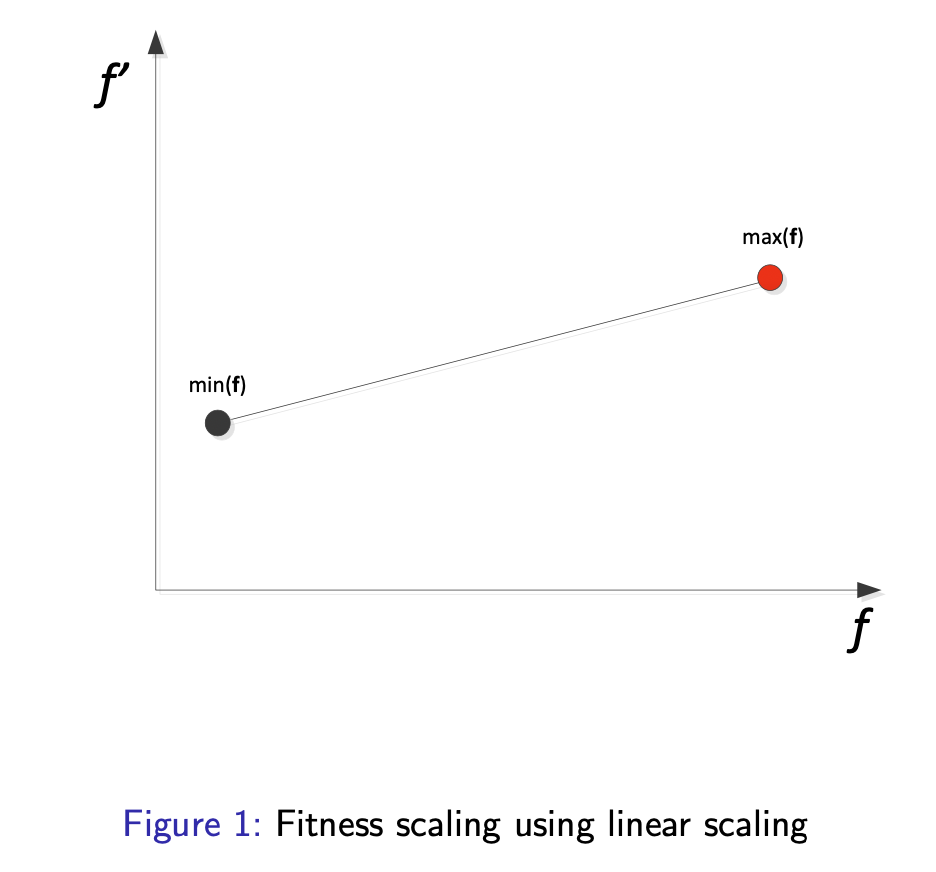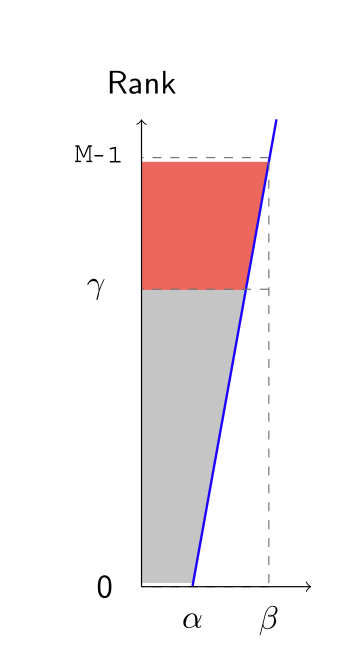Selection and Reproduction 選擇與繁殖
Generic Evolutionary Algorithm 通用進化算法
$X_0$ := generate initial population of solutions
terminationflag := false
t := 0
Evaluate the fitness of each individual in $X_0$.
while (terminationflag != true)
Selection: Select parents from $X_t$ based on their fitness.
Variation: Breed new individuals by applying variation operators to parents Fitness calculation: Evaluate the fitness of new individuals. Reproduction: Generate population $X_{t+1}$ by replacing least-fit individuals
t := t + 1
If a termination criterion is met: terminationflag := true
Output $x_best$
Selection 選擇
Selection is not a search operator but influences search performance significantly 選擇不是搜索運算符,但會顯著影響搜索性能
Selection usually is performed before variation operators: selects better fit individuals for breeding 選擇通常在變異算子之前進行:選擇更適合的個體進行育種
Selection: emphasises on exploiting better solutions in a population: 強調在群體中開發更好的解決方案:
- Select one or more copies of good solutions. 選擇一份或多份好的解決方案。
- Inferior solutions will be selected but with a much less chance 將選擇較差的解決方案,但機會要小得多
Question: Why we still select those inferior solutions? 為什麼我們仍然選擇那些劣質的解決方案?
Selection Schemes 選擇方案
- Fitness Proportional Selection (FPS) 適應度比例選擇
- Ranking Selection 排名選擇
- Truncation Selection 截斷選擇
- Tournament Selection 比賽選擇
- and selection
Fitness Proportional Selection 適應度比例選擇
Fitness Proportional Selection (FPS) 適應度比例選擇 = Roulette Wheel Selection 輪盤選擇
Selecting individuals with a probability: 選擇個體 的概率為:
where is the fitness of individual and is the population size. 其中 是個體 的適應度, 是群體大小。
Does not allow negative fitness values. 不允許負的適應度值。
Individual with higher fitness will be less likely to be eliminated, but still a chance that they may be (Discuss later). 適應度較高的個體不太可能被淘汰,但仍有機會被淘汰(稍後討論)。
Individual with low fitness values may survive the selection process: allows some weak individuals who may help escaping from local optima. 適應度較低的個體可能會在選擇過程中存活下來:允許一些弱的個體,這些個體可能有助於逃離局部最優解。
Fitness Proportional Selection: scaling 適應度比例選擇:縮放
Observation: in early generations, there might be a domination of "super individuals" with very high fitness values 在早期代,可能會有一些"超級個體"擁有非常高的適應度值
Question: what problems will "super individuals" cause in EAs? 什麼問題會導致"超級個體"在 EAs 中產生?
Observation: In later generations, there might be no much separation among individuals 在後代,個體之間可能沒有太多的分離
Question: What are the problems in EAs with no much separation among individuals? 在沒有太多分離的 EAs 中有什麼問題?
Problems:
- Question: what problems will "super individuals" cause in EAs? 什麼問題會導致"超級個體"在 EAs 中產生?
- Answer: Premature convergence to a local optimum 早期收斂到局部最優解
- Question: What problems will caused in EAs with no much separation among individuals? 在沒有太多分離的 EAs 中有什麼問題?
- Answer: Slow convergence 慢速收斂
Question: How to maintain the same selection pressure throughout the run? 如何在運行過程中維持相同的選擇壓力?
Solution: replace raw fitness values with a scaled fitness value 用縮放的適應度值 代替原始的適應度值
Linear scaling:
$$ f_i^{\prime}=a+b \cdot f_i $$
where a and b are constants, usually set as and , where

Ranking Selection 排名選擇
Sort population size of M from best to worst according to their fitness values: 根據適應度值將群體大小為 M 的個體從最好到最差進行排序:
$$ x{(M-1)}^{\prime}, x{(M-2)}^{\prime}, x{(M-3)}^{\prime}, \cdots, x{(0)}^{\prime} $$
Select the top -ranked individual with probability , where is a ranking function, e.g.
- linear ranking
- exponential ranking
- power ranking
- geometric ranking
Linear Ranking Function 線性排名函數
Linear ranking function:
where implies and 1 ≤ ≤ 2
In expectation
- Best individual, i.e., , reproduced times: .
- Worst individual, i.e., , reproduced times: .
Question: how to set and to make EA behave like a random search algorithm?

Other Ranking Functions 其他排名選擇函數
Give you different, usually non-linear relationships between the rank γ and the selection probability :
Power ranking function:
Geometric ranking function:
Exponential ranking function:
where is a normalising factor and .
Truncation Selection 截斷選擇
- Steps:
- Rank individuals by fitness values
- Select some proportion, , (e.g. ), of the top ranked individuals
- Usually, k = 0.5 (top 50%) or k = 0.3 (top 30%)
- Can be seen as the simplest, deterministic ranking selection
Tournament Selection 比賽選擇
- Tournament selection with tournament size k:
- Step 1: Randomly sample a subset of k individuals from population
- Step 2: Select the individual in with highest fitness Repeat Steps 1 and 2 until enough offspring are created
- Among the most popular selection methods in genetic algorithms
- Binary tournament selection is the most popular one
and selection
- First proposed in Evolution Strategies. 首先在演化策略中提出。
- selection:
- Parent population of size
- Generate offspring from randomly chosen parents
- Next population is best individuals among parents and offspring
- selection where
- Parent population of size
- Generate offspring from randomly chosen parents
- Next population is best individuals among offspring
Selection Pressure 選擇壓力
- Selection pressure: degree to which selection emphasises on the better individuals. 選擇壓力:選擇強調優秀個體的程度。
- Question 1: How does selection pressure affect the balance between exploitation and exploration? 選擇壓力如何影響探索和開發之間的平衡?
- Answer 1:
- Higher selection pressure → exploitation → fast convergence to local optimum, e.g., premature
- Low selection pressure → exploration → slow convergence
- Question 2: Given an EA with a selection scheme, how will you measure selection pressure? 給定一個具有選擇方案的 EA,如何衡量選擇壓力?
- Answer 2: Take-over time [1]:
- Let's assume population size is M and initial population with one unique fittest individual
- Apply selection repeatedly with no other operators.
- is number of generations until population consists of only.
- Higher take-over time means lower selection pressure.
[1]: Goldberg, D. E. and Deb, K. (1991). A comparative analysis of selection schemes used in genetic algorithms. In Foundations of Genetic Algorithms. Morgan Kaufmann.
| Selection function | τ∗ ≈ | Note |
|---|---|---|
| Fitness prop. | Assuming a power law objective function f (x) = xc | |
| Linear ranking | 1≤β≤2 | |
| Truncation | ||
| Tournament | tournament size | |
Reproduction 繁殖
Reproduction: to control how genetic algorithm creates the next generation 繁殖:控制遺傳演算法如何創建下一代
Generational vs Steady state 世代 vs 穩態
- Generational EAs: also called standard EAs, use all new individuals after variations to replace the worse individuals in the old population to create a new population (then selection) 世代式 EA:也稱為標準 EA,在變異後使用所有新個體來取代舊世代中較差的個體以創建新世代(然後選擇)
- Steady state EAs: only use a few or even one single new individual to replace the old population at any one time 堅定狀態 EA:只在任何一個時間點使用一些甚至一個新個體來取代舊世代
n-Elitisms: always copy the N best individuals to the next generation n-Elitisms:總是將 N 個最好的個體複製到下一代
Generational gap: the overlap (i.e., individuals that did not go through any variation operators) between the old and new generations. 世代間隙:舊世代和新世代之間的重疊(即沒有經過任何變異運算子的個體)。
Conclusion 結論
- Selection and reproduction are two important ingredients of EAs 選擇和復制是 EA 的兩個重要組成部分
- The major difference between selection methods is based on: 選擇方法之間的主要差異在於:
- Relative fitness: fitness proportional selection 相對適應度:適應度比例選擇
- Ranking: tournament, truncation, (μ + λ) and (μ, λ) 排名:比賽,截斷,(μ + λ)和(μ,λ)
- Takeover time: quantitative measure of selection pressure 接管時間:選擇壓力的定量衡量
- Selection pressure is used to control the balance between exploitation and exploration: 選擇壓力用於控制探索和開發之間的平衡:
- Higher selection pressure → exploitation → fast convergence to local optimum, e.g., premature 更高的選擇壓力 → 利用 → 快速收斂到局部最優,例如,過早
- Low selection pressure → exploration → slow convergence 低選擇壓力 → 探索 → 慢速收斂